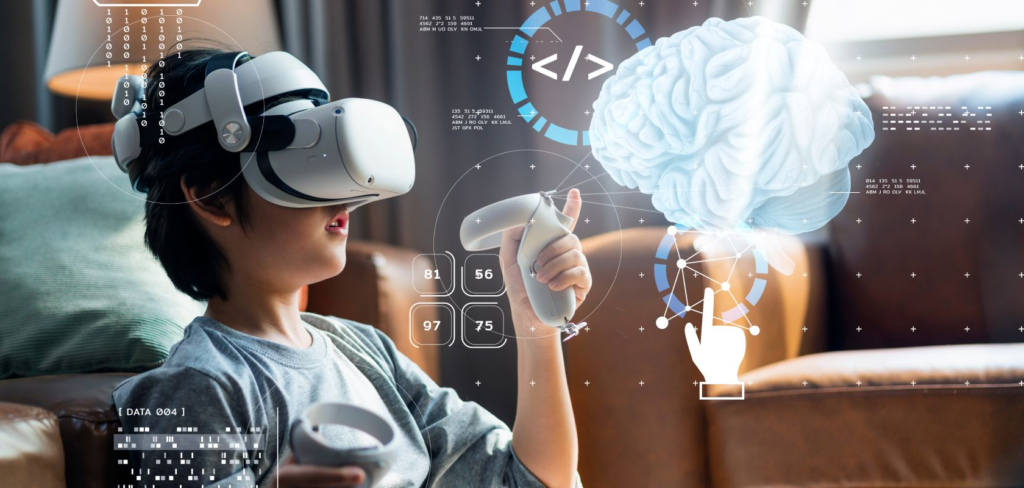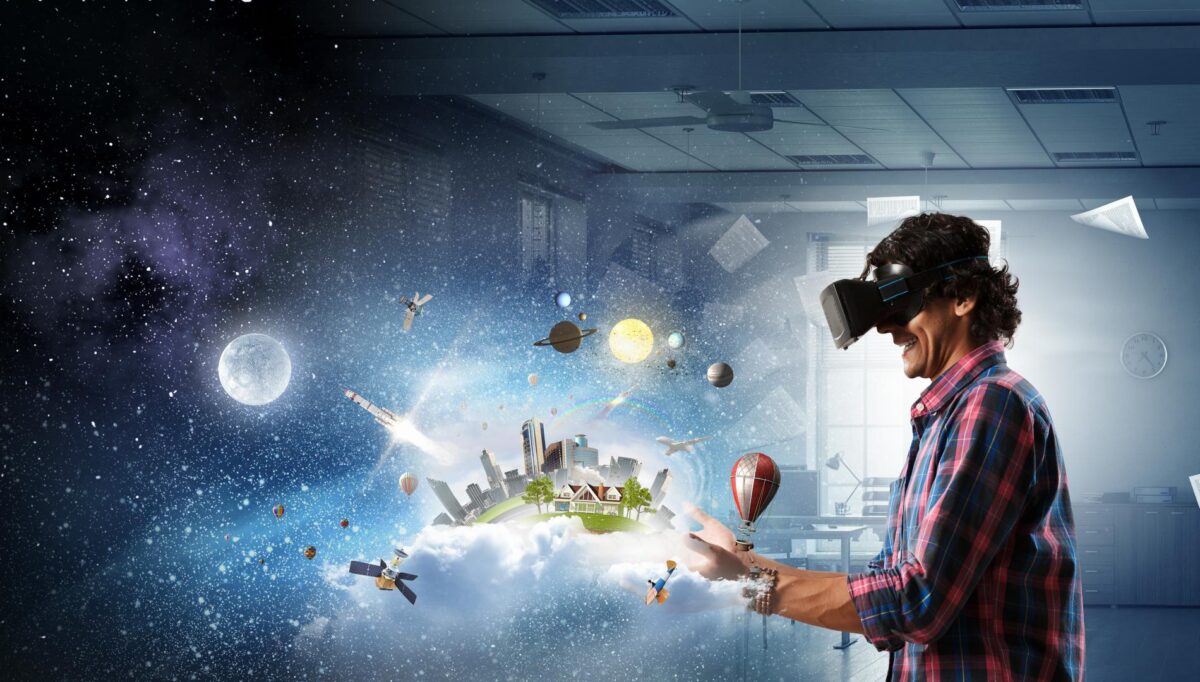Augmented reality (AR) and virtual reality (VR) stand out as two of the most intriguing technological innovations today, rapidly advancing and reshaping various fields. These technologies, once the stuff of science fiction, now offer immersive experiences that can fundamentally alter how we engage with the world. As we explore the world of AR and VR, we’ll examine their applications across different industries, consider their benefits and challenges, and envision what the future might hold for these cutting-edge technologies.

Understanding Augmented Reality (AR) and Virtual Reality (VR)
What is Augmented Reality (AR)?
Augmented Reality (AR) is a technology that overlays digital information, such as images, sounds, and text, onto the real world. Unlike Virtual Reality, which creates an entirely virtual environment, AR enhances the user’s perception of the real world by adding interactive elements. This blending of the physical and digital realms allows users to experience a more enriched version of reality.
What is Virtual Reality (VR)?
Virtual Reality (VR) immerses users in a completely virtual environment, typically through the use of a VR headset. In VR, users are transported to a computer-generated world that can be designed to replicate real-world settings or entirely fantastical environments. This technology is often used in gaming, training simulations, and various forms of entertainment, providing an immersive experience that can be both engaging and transformative.
Applications of AR and VR
1. Gaming and Entertainment
AR in Gaming
One of the most well-known applications of AR is in gaming, where it brings digital characters and environments into the real world. Games like Pokémon GO and Harry Potter: Wizards Unite have popularized AR gaming by allowing players to interact with virtual elements within their physical surroundings.
VR in Gaming
Virtual Reality has taken gaming to a new level by offering players an immersive experience that traditional gaming cannot match. VR headsets like the Oculus Rift, HTC Vive, and PlayStation VR allow players to step into their favorite games, offering a 360-degree view and full-body interaction. Games like Beat Saber and Half-Life: Alyx have set new standards for what VR gaming can achieve.
2. Education and Training
AR in Education
Augmented Reality is revolutionizing education by providing interactive learning experiences. AR apps like Google Expeditions allow students to take virtual field trips to historical sites, outer space, or inside the human body. By overlaying digital content onto real-world objects, AR can make learning more engaging and accessible.
VR in Training
Virtual Reality is increasingly being used for training in various industries, from healthcare to aviation. For example, medical students can practice surgeries in a risk-free virtual environment, while pilots can simulate flights in VR to hone their skills. This technology provides a safe and controlled environment for learning complex tasks.
3. Healthcare
AR in Healthcare
AR is being used in healthcare to assist in surgeries, visualize medical data, and provide patient education. Surgeons can use AR to view 3D models of organs overlaid on a patient’s body during surgery, improving precision and outcomes. AR can also help doctors explain medical conditions to patients by providing interactive visual aids.
VR in Therapy
VR has shown promise in treating various mental health conditions, including PTSD, anxiety, and phobias. Virtual environments can be tailored to expose patients to controlled scenarios that help them confront and manage their fears. Additionally, VR is being used in physical rehabilitation to create engaging exercises that aid in recovery.
4. Retail and E-commerce
AR in Shopping
Augmented Reality is transforming the retail industry by offering virtual try-ons and product visualization. Apps like IKEA Place allow customers to see how furniture will look in their homes before making a purchase. Similarly, fashion retailers use AR to let customers try on clothes or accessories virtually.
VR in Virtual Stores
Some retailers are experimenting with VR to create virtual stores where customers can browse products in a fully immersive environment. This approach offers a unique shopping experience, combining the convenience of online shopping with the experience of being in a physical store.
5. Real Estate and Architecture
AR in Real Estate
AR is making it easier for real estate agents to showcase properties by allowing potential buyers to take virtual tours of homes. Prospective buyers can use AR apps to visualize how a property would look with different furniture or renovations, helping them make more informed decisions.
VR in Architecture
Virtual Reality is being used in architecture to create immersive walkthroughs of building designs. Architects can use VR to present their ideas to clients in a more interactive way, allowing clients to experience a building before it is constructed. This can help identify potential design issues early in the process.
6. Tourism and Travel
AR in Tourism
AR is enhancing the travel experience by providing tourists with interactive guides. For example, AR apps can overlay historical information onto landmarks or provide navigation assistance in real-time. This technology makes exploring new places more informative and engaging.
VR in Travel
Virtual Reality offers the possibility of virtual tourism, where users can explore destinations from the comfort of their homes. VR travel experiences can transport users to famous landmarks, museums, or even remote natural wonders. While it may not replace physical travel, VR provides a unique way to experience the world.
The Boon of AR and VR

1. Enhanced User Experience
AR and VR significantly enhance user experiences by providing immersive and interactive environments. Whether it’s for gaming, shopping, or education, these technologies offer a more engaging way to interact with digital content.
2. Improved Accessibility
Both AR and VR can make experiences more accessible to people who might not otherwise have the opportunity. For example, VR can allow students to visit places they might never see in real life, and AR can make complex subjects more understandable.
3. Innovation in Healthcare
AR and VR are driving innovation in healthcare, from improving surgical precision to offering new forms of therapy. These technologies are making medical procedures safer and more effective, and they are providing new tools for patient care.
4. New Opportunities in Retail
For retailers, AR and VR present new opportunities to connect with customers. Virtual try-ons, immersive shopping experiences, and interactive product visualizations are just a few ways these technologies are transforming the retail landscape.
5. Efficient Training and Education
AR and VR are revolutionizing training and education by offering interactive and immersive learning experiences. This can lead to better retention of information and more effective training, particularly in fields that require hands-on practice.
The Bane of AR and VR
1. High Costs
One of the biggest drawbacks of AR and VR is the cost of the technology. High-quality VR headsets and AR devices can be expensive, making them less accessible to the average consumer. Additionally, developing AR and VR content requires significant investment in time and resources.
2. Health Concerns
Extended use of VR can lead to physical discomfort, such as eye strain, headaches, and nausea. This is often referred to as “VR sickness,” and it can limit the amount of time users can spend in a virtual environment. AR, while less immersive, can still cause similar issues if used for prolonged periods.
3. Privacy and Security Risks
Both AR and VR technologies pose potential privacy and security risks. AR apps that use cameras to overlay digital content onto the real world could potentially be used to collect sensitive information without the user’s knowledge. VR platforms that require online connectivity can also be vulnerable to hacking and data breaches.
4. Social Isolation
While VR offers immersive experiences, it can also lead to social isolation if users spend too much time in virtual environments. This detachment from the real world can have negative effects on mental health and social well-being, particularly for individuals who are already prone to isolation.
5. Technical Limitations
Despite their potential, AR and VR technologies are still in the early stages of development and face several technical limitations. Issues like limited battery life, lower resolution, and a lack of standardized platforms can hinder the widespread adoption of these technologies.
The Future of AR and VR
1. Advancements in Hardware
As technology continues to evolve, we can expect significant advancements in AR and VR hardware. Lighter, more comfortable headsets with better resolution and longer battery life will make these technologies more accessible and appealing to a broader audience.
2. Integration with Other Technologies
AR and VR are likely to become increasingly integrated with other technologies, such as artificial intelligence (AI) and the Internet of Things (IoT). This integration will create more personalized and interactive experiences, further blurring the line between the physical and digital worlds.
3. Expansion into New Industries
While AR and VR are already making waves in gaming, healthcare, and retail, we can expect these technologies to expand into new industries. Fields like real estate, education, and manufacturing are likely to see increased adoption of AR and VR in the coming years.
4. Ethical Considerations
As AR and VR become more prevalent, ethical considerations will become increasingly important. Issues like data privacy, consent, and the potential for addiction will need to be addressed to ensure that these technologies are used responsibly.
5. Greater Accessibility
As the cost of AR and VR technology decreases, it will become more accessible to the average consumer. This increased accessibility will drive further innovation and adoption, making AR and VR a standard part of everyday life.
Conclusion
Augmented Reality and Virtual Reality are two of the most transformative technologies of our time, offering a wealth of possibilities across various industries. From gaming and entertainment to healthcare and education, AR and VR are changing the way we interact with the world and each other.
While these technologies offer many benefits, they also come with challenges that must be addressed. High costs, health concerns, and privacy risks are just a few of the issues that need careful consideration as AR and VR continue to evolve.
As we look to the future, it’s clear that AR and VR have the potential to revolutionize our lives in ways we are only beginning to imagine. By understanding both the advantages and drawbacks of these technologies, we can better prepare for a world where the lines between reality and the digital realm are increasingly blurred. Tech-arcis














